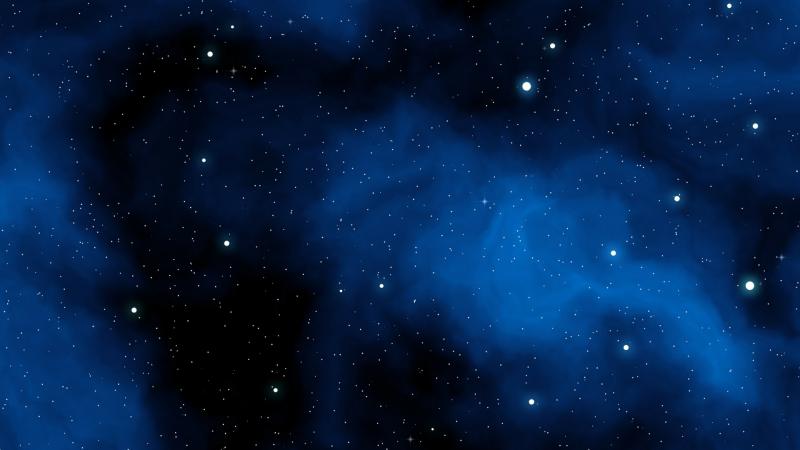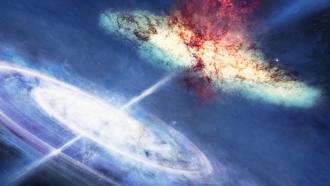
The year 2017 saw the first supercluster of galaxies discovered in India by an all Indian team. Named Saraswati, after the Indian goddess of music, art and knowledge, the supercluster is estimated to contain billions of stars, planets, gases, dark matter and other bodies. The estimated size of this supercluster is about 650 million light years across and the mass equivalent to over 20 million billion suns.
Joydeep Bagchi, lead author of the study that discovered Saraswati supercluster, feels that the project has demonstrated the expertise of Indian researchers, particularly those at IUCAA. This discovery is rare because it is one of the largest known structures out in the universe and only four or five such structures are known till date like the Shapley Concentration or the Sloan Great Wall. Saraswati is the farthest supercluster yet discovered. The discovery were published in The Astrophysical Journal, the research journal of the American Astronomical Society.
Saraswati is also the new poster boy of Indian astronomy. “This is the first supercluster of galaxies discovered in India by an all Indian team”, says Prof. Bagchi proudly. The team involved researchers from IUCAA, the Indian Institute of Science Education and Research (IISER), Pune, National Institute of Technology (NIT), Jamshedpur and Newman College, Thodupuzha.
Perhaps never before had our national pride been evoked in the recent past for such a landmark breakthrough. And that’s encouraging and builds confidence in Indians when global scientific journals and researchers recognise our achievements.
“In spatial size and total mass, Saraswati supercluster is easily one of the biggest superclusters ever observed”, points out Prof. Bagchi. It is extremely large, with 43 galaxy clusters, and is the farthest known to us yet, at least 10 times farther than well-known superclusters ‘Shapley Concentration’ and the ‘Sloan Great Wall’.
With this discovery, the researchers are elated that it might help to address our quest to understand the constituents of the Universe. “The fact that we could bring out some substantial new information in the field of Cosmology and Large Scale Structure Formation is of great satisfaction to us”, Prof. Bagchi says.
The discovery of Saraswati supercluster has enthused the scientific community for a variety of reasons. “Besides its immense size and mass, may be the most interesting thing about this supercluster is the fact that it was formed in an era many billions of years ago. We still do not know how many such gigantic superclusters may have formed at that time in the distant Universe, so it is a very important discovery”, he adds.
A galaxy, like our own Milky Way, is a group of stars bound together by gravity. There are about a hundred billion more such galaxies in our Universe. Over time, several of these galaxies group together further to form clusters, and multiple clusters form a supercluster. By gobbling up the gas and other matter around them, massive galaxy clusters grow over time. Our Milky Way, along with about 1300 neighboring galaxies, is today a member of the Virgo cluster, which is in turn part of the Laniakea supercluster.
_8.jpg)
“This supercluster being one of the farthest, located at a distance of about 4 billion light-years, and being most massive, can tell us more about the state of affairs of the early Universe. It has a big concentration of mass, mainly made up of galaxies and unseen dark matter, and is surrounded by a series of huge ‘voids’ -- bubble like structures almost devoid of matter. These voids, of diameter 100s of million light years, indicate that such superclusters are possibly formed by drawing matter from the surroundings”, explains Prof. Bagchi.
India has already become a world leader in the field of radio astronomy with the successful operation of the 100% indigenous Giant Meterwave Radio Telescope (GMRT) near Pune, which is currently the world’s largest and most powerful radio telescope in meter wavelength range. Moreover, with the highly successful Mars Orbiter Mission (MOM), Indian space scientists have demonstrated to the world that they can execute extremely complex and precise space missions at much lower costs than advanced nations. Recently several Indian scientists based in Pune, Bangalore and elsewhere had played a major role in the breakthrough discovery of Gravitational Waves by the international LIGO observatory, which led to 2017 Nobel Prize in Physics to three scientists.
In the case of Saraswati, what was merely a conjecture in 2002, by 2017 turned out to be completely correct! The scientists were elated to know that the cryptic ‘ZwCl 2341.1+0000’ galaxy cluster, that they have been observing for quite some time, is, after all, the second most massive cluster in the newly found supercluster, while another rich galaxy cluster Abell 2631, located right at the center, is the most massive one.
“Like many other important discoveries in science, the (discovery of the) Saraswati supercluster is a result of imagination, perseverance, long and painstaking hard work extending over 15 years (2002 to 2017) and finally identification and timely correction of some false steps on the way”, shares Prof. Bagchi. “The discovery is the result of concerted hard work of the entire team for many years. So the discovery and the associated logical establishment of it had been much exciting to our team”, he adds.
In the year 2000, Prof. Joydeep Bagchi started a major program at the Inter University Centre for Astronomy and Astrophysics (IUCAA), Pune, to search for large scale radio emissions from high energy particles that emanated from merging galaxy clusters. He then observed the surrounding filaments of the intergalactic medium, a concoction of hot and magnetized gas, being gobbled up by one of the merging galaxy clusters at very high speeds. These emissions, originating from ‘ZwCl 2341.1+0000’ (ZwCl stands for Zwicky Catalogue and the numbers are the astronomers’ equivalent of latitude and longitude) galaxy cluster, were unusual.
After a couple of years of observations, Prof. Bagchi and his collaborators, in 2002, published about the possible existence of an extremely large supercluster. And that was the first glimpse of what was yet to come.
“This potential supercluster was glimpsed while studying the characteristic properties of the unusual filaments of the merging galaxy cluster ZwCl 2341.1+0000”, says Prof. Bagchi. Based on further observations, the researchers concluded that the reported radio emission is clear evidence of some gigantic structure being formed in the magnetized intergalactic medium, whose size is more than 5 Mega parsecs (around 15 million light years), the first ever observation of its kind in astrophysics.
“The idea of an extremely large supercluster lurking in the vicinity was largely based on our educated guess work. Lack of data about galaxy redshifts, a measure used to determine the velocity of a galaxy, and hence infer its distance, back then, did not allow for the existence of this supercluster to be firmly established, but some of the right hints were already there”, says Prof. Bagchi.
What is special about being many billions of years old? “It was when the mysterious Dark Energy was starting to show its effect on the expansion of the Universe”, says Prof. Bagchi. “The matter in the Universe acts to slow down its expansion while Dark Energy has a negative pressure, so it accelerates it”, he explains. The discovery of this supercluster in the present time might be a result of a delicate balance between two opposites, the repulsive nature of Dark Energy and the attractive force of gravity, he believes, adding that this may be due to its existence in that era of cosmic time, when these two forces were almost equal.
It’s not all. Even if one wanted to, we cannot obtain much information about Dark Energy studying other clusters and superclusters closer to home. “It is because the Dark Energy dominates over gravity, and it does not allow any such large scale superclusters to form anymore”, reasons Prof. Bagchi. While scientists are still working out the details on how superclusters are formed in the Universe, this work, Prof. Bagchi says, will help to shed some light on how such extreme, large scale, prominent matter-density enhancements had formed billions of years ago when the mysterious Dark Energy had just started to dominate structure formation.
Superclusters like this are also excellent probes to understand gravity at these early stages of the universe. “Since a structure of this vastness will only evolve/grow extremely slowly, taking many billions of years, it carries with it, a sort of record of the entire history of its growth with it”, adds Prof. Bagchi.
What implications does this discovery has on understanding of astronomy today? “When astronomers look far away, they see the Universe from long ago, since light takes a while to reach us. The Saraswati supercluster is observed as it was when the Universe was about 10 billion years old”, explains Prof. Bagchi.
The long-popular “Cold Dark Matter” model of the evolution of the Universe predicts that small structures like galaxies form first, which congregate into larger structures. Most forms of this cosmological model do not predict the existence of large structures such as Saraswati, within the current age of the Universe. “The discovery of these extremely large structures thus forces astronomers to re-think popular theories of how the Universe got its current form, starting from a more-or-less uniform distribution of energy after the Big Bang”, he adds further.
It is believed that galaxies are formed mostly on the filaments and sheets that are part of the cosmic web, and many of the galaxies travel along these filaments, ending up in the rich clusters, where the crowded environment switches off their star formation and aids in the transformation of galaxies from disky blue spiral galaxies to red elliptical galaxies. Since there is an extensive variation of environment within a supercluster, galaxies travel through these varied environments during their lifetime. To understand their formation and evolution, one needs to identify these superclusters and closely study the effect of their environment on the galaxies.
“This is a very new research area -- with the aid of observations from new observational facilities, astronomers are now beginning to understand galaxy evolution. Our discovery will greatly enhance this field of research”, says Prof. Bagchi.
In addition, the researchers hope that this discovery opens up many exciting avenues for future work at various wavelengths. For example in optical wavelengths, a large spectroscopic survey of many more galaxies near the supercluster will help understand how the immense gravitational pull of matter in the supercluster is making the surrounding galaxies move away from voids and towards the filaments and sheets connected with the main supercluster. “We are planning a large scale survey of the Saraswati region with powerful radio telescopes like the Giant Meter Wave Radio Telescope (GMRT) in India and using the upcoming Square Kilometer Array (SKA) in South Africa and Australia, which will provide an unprecedented look into the high energy processes going on in the supercluster, like radio jets ejected from supermassive black holes residing in galactic centres, and cosmological shock waves arising from mergers of galaxy clusters and the resulting radio emission from high energy particles accelerated in the cosmological shock waves”, details Prof. Bagchi, giving us a glimpse of the exciting things to come.






